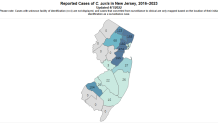What to Know
- Although Candida auris was just discovered in 2009, it has spread quickly and caused infections in more than a dozen countries. NY and NJ are among the most impacted US states, data shows
- It can cause bloodstream infections and even death, particularly in hospital and nursing home patients with underlying issues. More than 1 in 3 patients with invasive Candida auris infection, meaning one that affects the blood, heart or brain, die, according to the CDC
- The CDC says it's a serious global health threat because it is drug-resistant, easily misidentified and has caused outbreaks in healthcare settings, which is concerning given the more at-risk populations
A dangerous fungal infection that the CDC warned in March was spreading to an "alarming" degree across the U.S. continues to proliferate in New York, and while the rate of increase is slowing, it's still rising by double-digit percentage points on a month-to-month basis, new state data shows.
It's caused by Candida auris, a form of yeast usually not harmful to healthy people but that can pose a deadly infection threat to immunocompromised and otherwise vulnerable populations. It spreads easily and can infect wounds, ears and the bloodstream. Some strains are so-called superbugs, meaning currently available treatment may not work.
In cases where Candida auris infection becomes invasive, meaning it affects a person's blood, heart or brain, more than one in three patients die, according to the CDC.
Get Tri-state area news and weather forecasts to your inbox. Sign up for NBC New York newsletters.
The CDC describes it as an "emerging" fungus that "presents a serious global health threat" for three primary reasons: Candida auris is often multidrug-resistant (some strains don't respond to any of the three available antifungal drugs); it's easily misidentified in labs without specific technology, which could impair public health management; and it has caused outbreaks in healthcare settings, which are of particular concern given their more at-risk populations.
While the number of U.S. cases of Candida auris tripled between 2020 and 2022, few states have seen such rampant spread as New York, where a 2013 case was retroactively identified as America's first, and New Jersey.
The two states accounted for nearly a fifth of all U.S. candida auris cases last year, CDC data shows. Federal data only covers the period ending Dec. 31, 2022, so there's not yet a comparative reference point for 2023. Weekly data is available by U.S. state, but the CDC says that's incomplete because not all state health departments report it.
Newly released May data for New York state shows clinical case numbers continue to rise by double-digit percentage points, though the rate of increase is slowing slightly. The Big Apple's 149 clinical cases confirmed as of May 25, 2023, mark an increase of 42% since the last data update in early April. That follows a 46% month-over-month increase from March to April. So far, the 2023 total is 39% of the record-setting 379 cases from 2022 -- and there are six months left to go in 2023. That 379 number is the highest annual tally of clinical cases New York has seen in the last decade.
Another 250 potential Candida auris cases are under surveillance, state health department data shows.
New York Candida Auris Cases by Year
Most of the cases have been found in facilities in the New York City area, though some have been from outside the metropolitan area.
| Year | Number of Clinical Cases | Number of Surveillance Cases |
| 2013 | 1 | 0 |
| 2014 | 0 | 0 |
| 2015 | 0 | 0 |
| 2016 | 26 | 11 |
| 2017 | 99 | 128 |
| 2018 | 158 | 254 |
| 2019 | 178 | 306 |
| 2020 | 250 | 200 |
| 2021 | 291 | 348 |
| 2022 | 379 | 498 |
| *2023 | 149 | 250 |
| Total* | 1531 | 1995 |
New Jersey Case Trends
New Jersey has already blown past the 2022 total provided by the CDC, which is three times lower than the state's own data. The state has not updated its Candida auris case data since April 1. At that time, the current 127 Candida auris cases for this year (as of April 1) were 34% of last year's total. Again, there's a lot of year left to go.
It's not clear when the state plans to share May's data. Recent trends, though, indicate cases will keep climbing.

Both states saw their numbers increase dramatically over the last few years, and CDC researchers say the COVID-19 pandemic is likely at least partly to blame. Hospital workers were strained by COVID patients, and that likely shifted their focus away from disinfecting some other kinds of germs, they said.
Candida auris was first identified in Japan in 2009 and has been seen in more and more countries. Many of the first U.S. cases came from abroad, but most cases now spread within the country, officials say.
The fungus can survive on surfaces in healthcare locations, where it can spread between patients. Doctors have also detected it on the skin of thousands of other patients, making them a transmission risk. Those with multiple co-morbidities and who require a machine to breathe are at heightened risk if they catch the infection, health officials say.
Learn more about New York's response here and get CDC information for patients and family members, as well as tips on prevention, symptoms to look for and more, right here. New Jersey Candida auris information can be found here.



